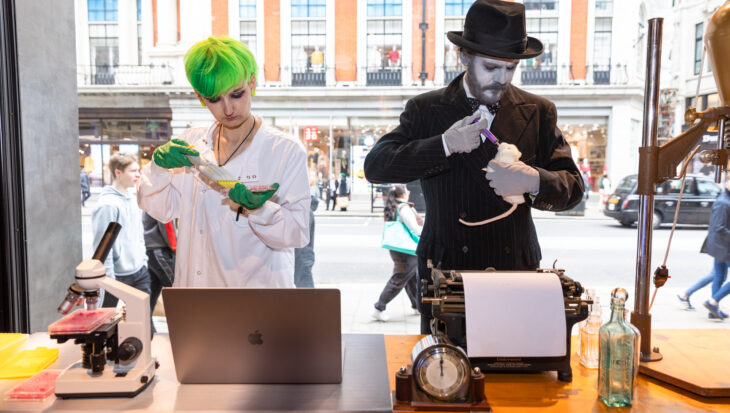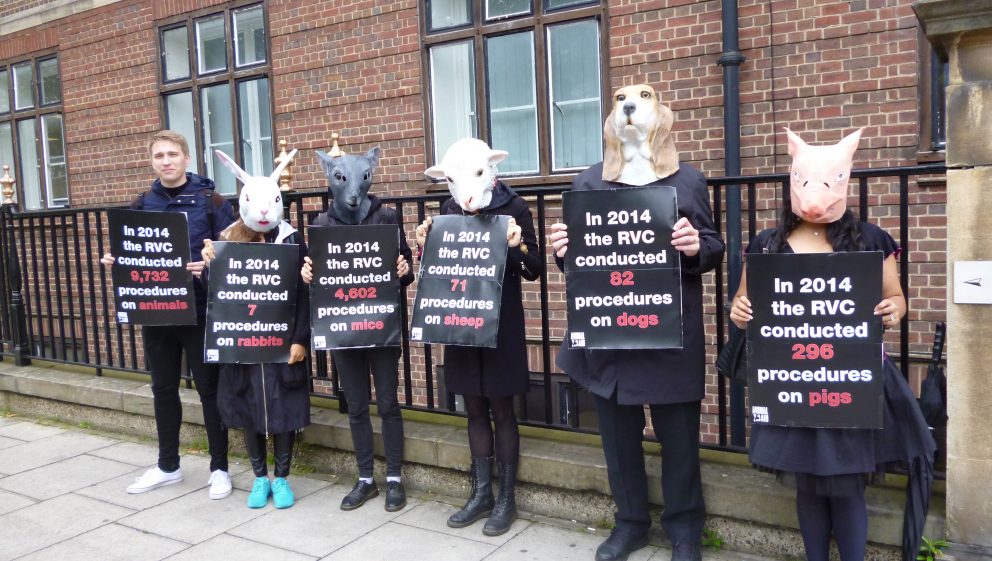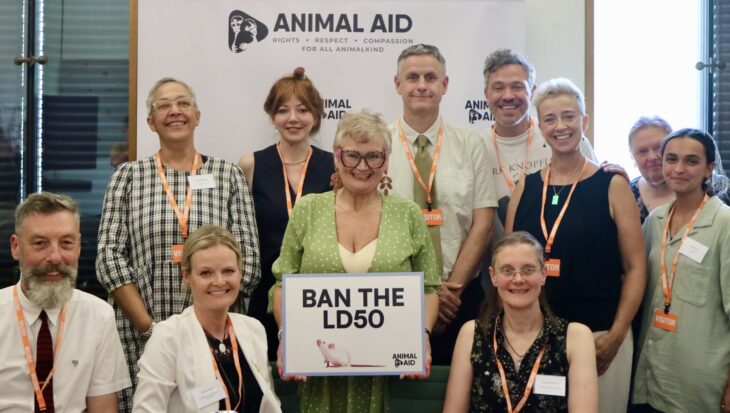The RVC’s little-known programme of invasive animal experiments involves thousands of procedures annually, and was highlighted by Animal Aid in January. When calling for an end to the tests at that time, the national pressure group invited the College to defend its position by publicly debating the issue. Animal Aid’s invitation has been unanswered.
The ongoing programme of research uses species as varied as cattle, dogs, zebrafish and salamanders. Beagle dogs have been dosed with an anti-cancer drug to study the resulting nausea and vomiting symptoms; guinea fowl have been forced to run on treadmills, the birds first having had electrodes inserted into their leg muscles; and pregnant sheep have been surgically mutilated to study uterine blood flow.
The latest revelations centre on sometimes catastrophic surgical errors and resource shortages that are catalogued in the reports of the College’s Animal Welfare and Ethical Review Body (AWERB). These were obtained by Animal Aid by making formal requests under the Freedom of Information Act.1
The AWERB reports cover a period from January 2015 to April 2016. A stark example of a system failure was the beagle puppies who were put down after suffering severe injuries as a result of an attack by an adult dog. Another AWERB report (26th January 2016), has an account of two sheep dying on the operating table because their pre-surgery food intake had not been controlled properly; also they had not been positioned correctly on the operating table and there had been a lack of adequate monitoring during anaesthesia. A third report details guinea pigs being euthanased because of ‘simple wound breakdown’. A pregnant ewe was another victim (June 2015) after being mistakenly used for an experiment – an error that led to her lamb being killed.
As well as these animals-in-crisis incidents, the AWERB reports note the lack of sufficient stimulation afforded some animals – dogs included. There are descriptions of what seem very much like a failure to meet their most basic needs. Unsurprisingly, a later report carries an account of a dog exhibiting stereotypic behaviour, that is to say obsessive, repetitive movements that are invariably triggered by stress or depression. In this case, the dog was bar-licking.
The College appears to know it is falling short of the standards expected of it. After an unspecified problem was highlighted by a Home Office Inspector, the rebuke in the AWERB report is robust: ‘It was very concerning that the staff had not spotted and resolved this themselves. The College as a veterinary school should be setting high standards for itself and not let conditions deteriorate.’
Animals kept for teaching purposes also face problems of inadequate facilities. This seems to be the cause of ‘unhappy ponies’. Similarly, we read of dogs ‘having a lack of stimulation, especially at weekends’ due to them being housed in the upper floor of a building, to which access was restricted.
Even without these examples of bad practice and resource shortages, the RVC’s programme of animal experiments is controversial within the college itself. RVC staff, who are used to treating companion animals, such as dogs, as clinical patients, ‘will want to know why’, says an AWERB report ‘we are involved in harming animals from the same species’. That question is now being asked by members of the general public who, through Animal Aid, have become aware of the scale and sometimes brutal nature of the RVC’s vivisection programme.
From the moment Animal Aid launched its campaign in January 2016, with an account of beagle-cross dogs being used for Duchenne Muscular Dystrophy research, people have responded to our revelations with outrage and incredulity. What makes the situation all the more tragic is that the RVC’s experiments on animals produce data that cannot be relied upon, whether for human or veterinary medicine.(2)
Says Jessamy Korotoga, Animal Aid’s Anti-Vivisection Campaign Manager:
‘The RVC’s programme of animal research, which involves 9,000 animals per year, is bad enough. Now we discover fights, deaths, inadequate welfare and poor practices, which really do paint a shameful picture of the college. We are asking the RVC to stop its programme of animal research now, and to do what the public expect of it – heal animals, not harm them.’
Notes for editors
- Animal Aid visited RVC on their Open Day on 29 June to inform prospective students of the animal experiments that are carried out at the College:

- The information gathered was from the Animal Welfare and Ethical Review Board (AWERB) reports from January 2015 to April 2016. These were requested under the Freedom of Information Act, 2000. An AWERB is tasked with, among other duties, the application of the 3Rs (reduction, replacement and refinement) and establishing and reviewing processes relating to animal welfare.
- In January, Animal Aid highlighted the plight of a colony of beagle-cross dogs, who were bred at the College for use in experiments that were intended to help humans with Duchenne Muscular Dystrophy. The animals were to be killed when they were 18 months of age, to prevent their condition worsening.
- As to the euthanased pups, it was stated ‘Several learning points had been identified following the incident to reduce the risk of this happening again’. Standard operating procedures were also rewritten to incorporate methods of controlling dog fights in the future ‘including the use of water’.
- For Animal Aid’s previous analysis of the animal research programme and associated issues, please visit our website.
- To arrange an interview with Jessamy Korotoga, Animal Aid’s Anti-Vivisection Campaign Manager, please call 01732 364546
Notes
- AWERBs are committees that each Home Office licensed research establishment is required, by law, to establish.
- A wealth of evidence demonstrates that data generated from animal ‘models’ of human disease cannot be reliably applied to human medicine. Another set of problems mean that research data cannot be trusted even where, for example, dogs are experimented upon to find a cure for the dog population – see note 3 for more on this issue.
- A wealth of evidence demonstrates that data generated from animal ‘models’ of human disease cannot be reliably applied to human medicine. This is due to differences between species, on every physiological level (from cells to whole organ systems). Problems also arise because the disease or damage won’t be naturally occurring but will have been artificially induced in the animal (e.g. by chemical poisoning to produce a cancer, or through surgical mutilation to mimic organ failure). Another key shortcoming is that drugs work differently in different species. What cures cancer in a mouse is often ineffectual in humans; and what poisons a human being, may have little impact on a dog.Another set of problems means that the data cannot be trusted, even where, for example, dogs are being experimented on to produce a drug for dogs. The laboratory environment itself is a problem, given the associated stressors, such as blood tests, close confinement, biopsies and separation from natural family groupings, and the inability to engage in natural behaviours. The proximity of humans is an additional source of stress not to be underestimated. All of these factors combine to influence test results and render them unreliable.



